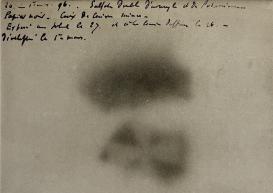In the wake of the nineteenth-century invention of photography, the historical semantics of "exposure" broadened to include exposing a sensitized surface to the action of actinic rays. As this new art developed, its practitioners experimented with different methods and setups, employing them to investigate and document the effects of exposure, not only with respect to how wavelengths of visible light can elicit changes on a sensitized surface, but other kinds of rays as well.
Exposure, as a mode of objectification, as well as a model for experimentation, is thus dependent upon documentary devices, materializing in the felicitious mating of vectors and sensitized matter, the affordances of both conditioning the representational, epistemic, and aesthetic dimensions exposure acquires. As these materializations of exposure circulate, such acts of exposure acquire other semantic entailments: exposure as a matter of unrevealing or disclosing, proving events as forms of evidence and affecting different publics.
This research project explores this doubled aspect of exposure as both relation and effect, examining how it becomes registered across a range of material surfaces and scales, and differentially mobilized in the making, or deferring, of political, epistemic, and ethical claims. To do so, it uses historical and ethnographic methods to examine how the logic and grammar of exposure has become an integral component of environmental knowledge through documentary and counter-documentary practices. The project concentrates on three different agents of exposure (sulfur dioxide, radiation, and noise) within three different contexts, as well as the collective action spawned in relation to their documented effects on unprotected forms of life. The first context focuses on radiation exposure among Indigenous communities and alliances collectivizing against histories of injustice in the Navajo Nation. The second is situated within the Kankoyo township in the Zambian Copperbelt, whose residents have been exposed to "senta" (the local word designating emissions of smelting) since 1937 but under various regimes: first colonial, then state-owned, and now privatized. The third is in Germany, where a toxicological model permeates knowledge and regulation regarding noise exposure above and below ground, with varying accountability. Overall, this project will contribute to understanding the potentials and limits of exposure as a form of epistemic action within contemporary contestations of environmental knowledge, risk, and crisis talk.

